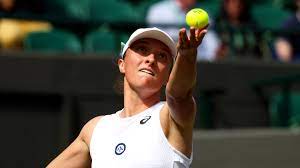At 21 years old and already a superstar in her home country of Poland, Swiatek is a bona fide No. 1 with a package of tennis skills both innate and acquired.
Iga Swiatekbeat Ons Jabeur in straight sets to win her first U.S. Open women’s singles title.
Iga Swiatek has won titles in six high-profile cities this year, and it should be no surprise to anyone, not even an emotional Swiatek, that she added New York to the long list on Saturday afternoon.
Her 6-2, 7-6 (5) victory over Ons Jabeur in Saturday’s U.S. Open women’s final was a reminder of what makes Swiatek such a force:
Phenomenal, elastic, sliding defense into the corners, often out of the near-splits popularized by Kim Clijsters and Novak Djokovic.
Sprinter’s speed moving forward. (She chased down Jabeur’s signature drop shots on Saturday like a cheetah chasing down a wounded impala.)
Heavyweight punching power and penetration off the ground, above all the topspin forehand like Swiatek’s role model Rafael Nadal.
Big-match mental strength, which has allowed her to find and maintain her focus under duress with the help of her longtime performance psychologist and friend, Daria Abramowicz. She is now 10-1 in tour-level singles finals.
That package of skills, both innate and acquired, has created a genuine champion, and what should be genuinely scary to the opposition is that she can still improve her serve, transition game and volleys by big margins.
At just 21 years old, Swiatek is a bona fide No. 1 with a huge lead in the rankings over Jabeur, the engaging and gifted Tunisian who will be back at No. 2 on Monday.
Swiatek will have 10,365 points to Jabeur’s 5,090: the kind of clear separation that great players like Williams or Steffi Graf have created in the past. And the last woman to win seven or more singles titles in a season was Serena Williams in 2014.
“That was my goal, to get to 10,000 points,” said Tomasz Wiktorowski, Swiatek’s coach who joined her team in December and has been one of the architects of her great season.
After winning the French Open by surprise in 2020 and then solidifying her spot in the top 10, Swiatek has taken flight in earnest in 2022, reeling off 37 straight victories earlier this season, often by lopsided Grafian margins, and winning a second French Open and — after a short market correction in July and August — her first U.S. Open.
With three majors, she is now closing in on Naomi Osaka, the Japanese star and former No. 1 who has won two U.S. Opens and two Australian Opens, as the most accomplished major champion of their generation.
But Swiatek, who is three years younger than the 24-year-old Osaka, already has one significant performance edge. While Osaka has never won a tour-level title on clay or grass, Swiatek is a multisurface threat. Of her seven titles this season, three have come on her long-favored red clay, but four have come on hardcourts like those used at the U.S. Open.
“I wasn’t sure if I was on the level yet to win actually a Grand Slam, especially on U.S. Open where the surface is so fast,” she said of hardcourts. “It’s something that I wasn’t expecting, for sure. It’s also like a confirmation for me that sky is the limit.”
The sky should include Wimbledon. Though Swiatek has yet to get past the fourth round on the grass at the All England Club, she did win the junior title there in 2018 and has the tool set and improvisational athleticism to win the main event there down the road.
It will be intriguing to see if Swiatek, already a superstar in her home nation of Poland, can break out globally, as well. She is smart and empathetic, likes to read and can crack a joke when she is not cracking a forehand. Handed the $2.6 million champion’s check on Saturday, she said, “I’m really glad it’s not in cash.”
Though she said in an interview in May in Paris that she was still trying to sort through the best way to use her new platform, she has demonstrated a new willingness and confidence to speak out since then. She organized an exhibition to raise relief funds for young Ukrainians in July in Poland and is the only leading player not from Ukraine to still wear a blue and yellow ribbon on court to mark her support for Ukraine in the war with Russia.
“Society, we don’t have a long memory, but, I mean, lives are at stake so I think we should remind people,” she told me at Wimbledon, which barred players from Russia and its ally Belarus.
But it is her tennis that has spoken the most loudly and eloquently in 2022, and while she swept through the draw to win the French Open, she had to play through stormy weather in New York — coming back to defeat Jule Niemeier and Aryna Sabalenka in three sets — before securing the trophy under clear skies.
“For sure, Roland Garros I always feel like I have more control, and I feel like Philippe Chatrier is kind of my place,” she said of the center court in Paris. “Here on Ashe, I still need to figure out the atmosphere. I wasn’t sure before the match if this is actually my place.”
Even during Williams’s quarter century at or near the top, the women’s game often lacked a transcendent rivalry. There has been nothing quite like Graf vs. Monica Seles; certainly nothing like Chris Evert vs. Martina Navratilova, who was in sold-out Arthur Ashe Stadium on Saturday to present the women’s trophy to Swiatek.
Credit The New York Times




